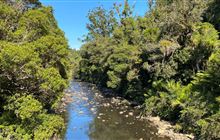Arahura River restoration
Introduction
Arahura River on the South Island’s West Coast is one of 14 priority catchments in our Ngā Awa river restoration programme.Arahura River has its source in alpine Lake Browning and travels down through natural tussock, rata-kamahi and other forest.
Some plantation forestry occurs in the mid and lower parts of the catchment and land beside the lower reaches is used for dairy farming. The Arahura enters the sea about 8 km north of Hokitika.
The upper reaches of the river are part of Waitaiki Historic Reserve and managed by Māwhera Incorporation. In 1976 the riverbed itself was formally returned to Māwhera, making it the only New Zealand river that is not publicly owned.
Arahura River is a prized source of pounamu (greenstone), which makes it highly significant to many people in and beyond the local area. The river generally has good water quality, mainly due to high rainfall and its unmodified upper catchment.
The goal of the restoration is to return the river to the healthy state known by previous Ngāti Waewae generations.
See a map of the Arahura river catchment (PDF, 817K)
Treaty partner and project partners
Te rūnanga o Ngāti Waewae, including Māwhera Incorporation, are Treaty partners. They are represented on a steering group that provides essential guidance for the restoration work.
Other partners include West Coast Regional Council, Westland District Council, Westland Milk Products, local landowners and the community.
Current restoration work
Arahura catchment: Physiographic stocktake
This report presents an environmental stocktake and a set of maps for the Arahura catchment.
Physiographic zones, such as bedrock or oxidising soil and aquifer, influence water quality in different ways. Mapping the zones provides a better understanding of how contaminants move through a landscape. This understanding can help guide management to improve water quality.
The maps and more information are also available from LandscapeDNA.
Arahura catchment: Physiographic stocktake (PDF, 6,666K)
Te Oha Haumanu o Te Awa Arahura: Arahura River baseline report
A review of the river’s biodiversity and cultural and ecological values was carried out in 2020. It details mana whenua values, ownership and management responsibilities. The river’s features, history, land cover, land use and water quality are described, as well as the plants and animals present, including pests.
Opportunities for restoration work in the upper, mid and lower areas of the catchment are listed, as well as the priority projects identified at a hui.
Read the report (PDF, 11,282K)
Dung beetles released
The first dung beetles were released on dairy farms in the Arahura catchment in early 2022. Though not native to Aotearoa New Zealand, the beetles make the nutrients in dung more available to pasture plants. This improves the pasture and stock health and reduces the need for drenching. It also provides better soil structure and greatly reduces the amount of dung that reaches waterways via runoff.
The release was organised by the Arahura catchment group. This group has grown from our partnership with Māwhera Incorporation and Te Runaka Ngāti Waewae that was initiated by Ngā Awa.
Clarifying values and aspirations
With our treaty partners and the community, we are developing a shared vision for the restoration work. Hui (meetings) have been held and a wānanga (conference) took place at Arahura marae in 2019.
The work involves identifying threats to the river, including from intensifying farming in the lower part of the catchment.
Improving river habitat
Providing more natural vegetation beside the river helps to reduce the amount of sediment and nutrients entering a river and creates spawning sites for whitebait. Challenges in this catchment include high rainfall and natural erosion (slips in the hills and erosion on riverbanks) and difficult access.
Planting natives beside some Arahura River tributaries is planned, although previously planted areas have been washed out by floods. Because this will require a large number of locally sourced plants, we are working with local volunteer and iwi groups to set up a nursery.
Arahura has some introduced willows on its banks and woody weeds in the braided riverbed – its health would improve if they were removed.
Survey of īnanga spawning grounds
This 2020 report summarises results from surveys of the lagoon at the mouth of the Arahura River, including:
- the salinity of the lagoon during a representative spring high tide
- surveys of the quality of īnanga habitat
- spawning surveys in autumn to locate spawning sites.
Salinity of the river mouth lagoon system
A preliminary report lists the salinity in different parts of the river and associated areas on a spring high tide, and includes photos of these areas.
Pest trapping
Populations of some threatened species in the catchment are being protected and monitored, including whio/blue duck. Predator control has allowed birds including weka and kereru to become more numerous. Some of this work has been carried out by OSPRI. Further predator control could benefit these and other species.
Contact
If you have any questions or want to get involved, email us.
Email: info@doc.govt.nz

About Ngā Awa river restoration
Ngā Awa is a programme working collaboratively in priority catchments to restore freshwater biodiversity.




